| Author: | |
| Website: | |
| Page title: | |
| URL: | |
| Published: | |
| Last revised: | |
| Accessed: |
An angle (from the Latin angulus, meaning corner) is created whenever two line segments or rays meet at a common end point. Wherever this occurs, two angles are formed. Normally, one of the angles will be an acute angle, a right angle or an obtuse angle. The other angle will be a reflex angle (the meaning of these terms is illustrated below). The rays or line segments form the sides of each angle, while the point at which the sides meet forms the vertex of each angle. In some cases, two rays or line segments may converge on a common point from opposite directions. If this is the case, both of the angles created will be straight angles. If the two rays or line segments are both pointing in the same direction, a single angle is formed which is a complete rotation (a second angle is sometimes said to exist, called the zero angle). Here are the different kinds of angle you will encounter:
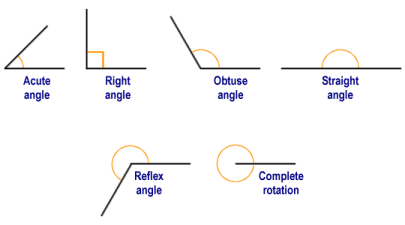
Different types of angles created at the junction of two rays or line segments
The size of the angles created by two rays or line segments is dependent on the degree to which one of the lines would need to be rotated around the point of convergence, either clockwise or anti-clockwise, in order for both of the lines to be pointing in the same direction. The main unit of measurement used to describe the size of an angle is the degree (or degree of arc). The degree symbol is a small raised circle ("°") which appears immediately following a number to denote that the number represents the size of an angle in degrees (note that the same symbol is used to represent temperature values expressed as degrees, but the context in which appears is usually sufficient to prevent confusion between the two). One degree represents a rotation of one three hundred and sixtieth (1/360) of a full circular rotation.
If an angle must be written with more precision than the use of degrees alone can provide, its value can be expressed using some number of decimal places (e.g. 48.75°). Alternatively, the degree is sometimes sub-divided into sixty equal units called arc minutes (or just minutes). Each of these units can itself be divided into sixty sub-divisions called arc seconds (or just seconds). This degree of precision is only really used in disciplines such as astronomy, or for specifying the latitude and longitude of a geographical location on earth, where very small differences can be significant. For the purposes of these pages, we will either express angles to the nearest degree or use decimal notation.
The different types of angle can be defined as follows:
A radian is the angle subtended by an arc of a circle (i.e. part of the circumference of a circle) whose length is equivalent to the radius of the circle. In other words, it is the acute angle created by the junction of two rays that originate from the centre of the circle and pass through opposite end points of the arc. The principle is illustrated below.
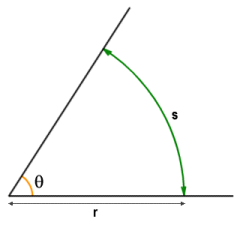
Angle θ is the angle subtended by arc s, and is one radian when the length of s equals that of r
For any arc s of a circle of radius r, the angle θ subtended by the arc (in radians) will be the quotient of s and r (i.e. the length of the arc divided by the radius of the circle). The circumference of a circle is given as 2πr where π (sometimes written as pi) is a constant with an approximate value of three point one four (3.14). Given that a circle represents one complete rotation of three-hundred and sixty degrees (360°), one radian represents an angle of just over fifty-seven degrees (57°), as the following calculation shows:
| 360 | ≈ | 360 | ≈ 57.3° |
| 2π | 6.28 |
We have seen that an angle is formed at the junction of two rays or line segments, which form the sides of the angle. The sign of the angle (i.e. whether it is considered to be positive or negative in value) depends on which of the two sides we measure the angle from. The side we choose for this purpose is called the initial side. The other side of the angle is called the terminal side. Angles are said to be positive if we measure the degree of rotation between the initial side and the terminal side in an anti-clockwise direction. If we measure the degree of rotation between the initial side and the terminal side in a clockwise direction, then the angle is said to be negative. Incidentally, if we wish to measure the angle of an oblique line, ray or line segment (i.e. any line, ray or line segment that is neither horizontal nor vertical) and an initial side is not specified, then the initial side is assumed to be the x-axis in the Cartesian plane.
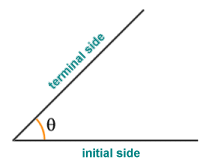
An angle is measured from the initial side to the terminal side
In the illustration above, θ denotes a positive angle of forty-five degrees (45°) and represents an anti-clockwise rotation between the initial side and the terminal side. The reflex angle (measured as a clockwise rotation between the initial side and the terminal side) would be a negative angle with a value of minus three hundred and fifteen degrees (-315°). Note that the concept of negative angles is not used in a navigational context. Compass bearings, for example, are always measured from north in the clockwise direction. A heading of north-west would therefore give a bearing of three hundred and fifteen degrees (315°).
As we have seen above, angles are often labelled using a letter from the Greek alphabet. The lower case Greek letter theta ("θ") is frequently used to identify an angle for which the value is initially unknown. Lower case characters from the Latin alphabet (e.g. a, b, c etc.) are also commonly used to identify angles. In the case of a geometric figure such as a triangle, the points that define the figure are often labelled using upper case Latin characters (e.g. A, B, C etc.). In the illustration below, the figure shown is a pentagon represented by points A, B, C, D and E. Since angle θ has sides defined by the line segments AB and AC, it may also be referred to using the notation ∠BAE or ∠EAB (note the use of the angle symbol, "∠"). The order in which the characters appear is not particularly important, so long as the character that identifies the vertex of the angle is in the middle.
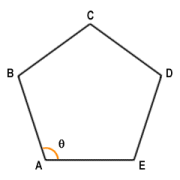
Angle θ may also be referred to as ∠BAE or ∠EAB
When labelling the vertices of a figure like the one illustrated, the convention is to label them clockwise, and in alphabetical order. If angles are identified using the labels of the three vertices that define them, a similar convention is normally adopted. The angle θ would therefore be identified as ∠EAB. Of course, the sign of the angle is not immediately obvious using this notation. Nor is it clear whether the angle referred to is the acute angle defined by the points E, A and B, or the reflex angle defined by the same points. The context will usually make it clear which angle is being referred to, and will allow the initial and terminal sides to be identified if necessary in order for the sign of the angle to be determined. Unless otherwise stated, it is usually assumed that the angle referred to is the smaller of the two angles (i.e. less than one hundred and eighty degrees), and that the sign of the angle is positive.
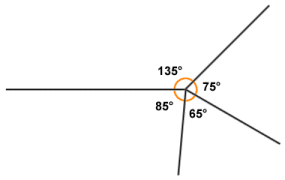
Angles around a single point sum to 360 degrees
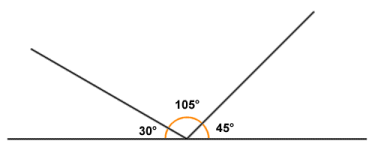
Angles around a single point on one side of a line sum to 180 degrees
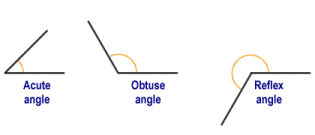
All of the above types of angles are oblique angles
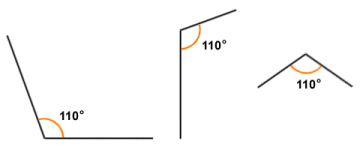
The three angles shown here are congruent
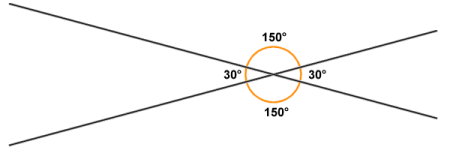
At the intersection of two lines, opposite angles are always equal
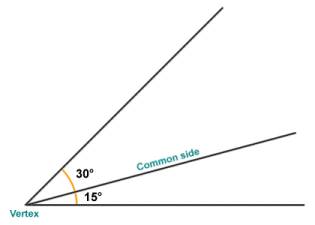
The angles shown here are adjacent
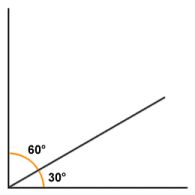
Two angles that sum to 90 degrees are said to be complementary
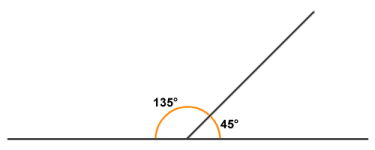
Two angles that sum to 180 degrees are said to be supplementary
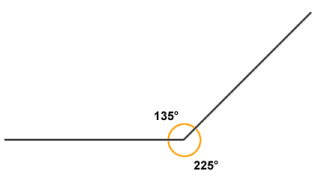
Two angles that sum to 360 degrees are said to be explementary
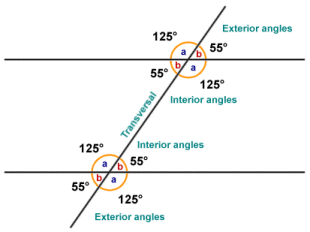
A line that crosses two parallel lines is called a transversal
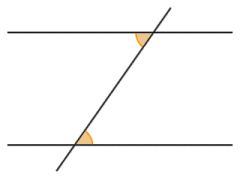
Alternate interior angles are congruent
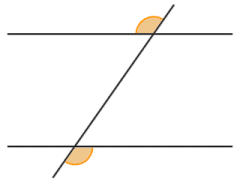
Alternate exterior angles are congruent